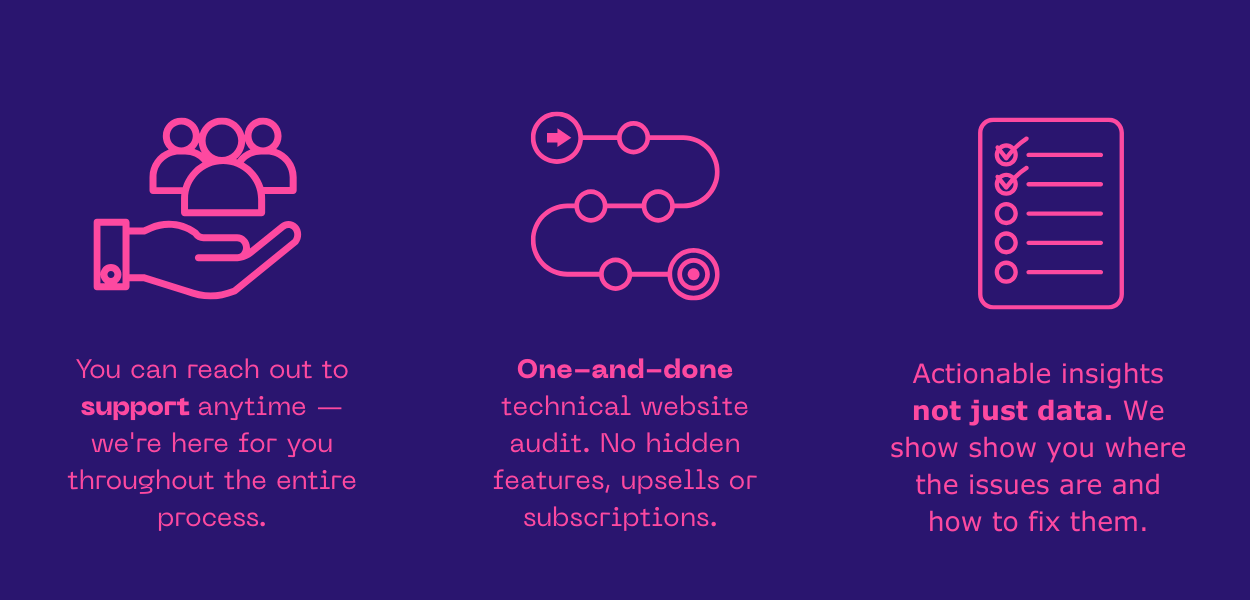Turning Insights Into Action: Why Pre-Campaign Website Audits Matter

Launching a marketing campaign, whether paid ads, newsletters, or influencer outreach, without verifying your website state is like sending guests to a party where the doors are locked or the lights are out. It costs clicks, lowers campaign ROI, and if web issues are severe, it can affect brand trust negatively. It can be disheartening when a campaign doesn't perform as expected, not due to messaging or targeting, but due to hidden website issues.
That’s where a quick website audit becomes crucial. The best campaigns ensure both the success of their concept and technical performance. And that starts with ensuring your site is technically sound, fast, and conversion-ready.
Top Reasons to Audit Your Website Before Launch
Maximise ROI (and Avoid Losing Revenue)
Amazon famously calculated that every 100ms delay in load time cost them 1% in revenue. (Optimizely). Even if you’re not operating at Amazon-scale, the principle holds: slow pages mean fewer conversions. According to the same source, 40% of users will abandon a site if it takes more than 3 seconds to load. That means every sluggish product page or laggy homepage click becomes a lost opportunity and wasted ad spend.
And it’s not just load time. Issues like broken links, unoptimized metadata, or poor mobile responsiveness can sink a campaign before it even starts. As Waypoint Marketing highlights, a strategic pre-campaign audit uncovered over 150 page errors on a B2B site, helping the client lift campaign-driven conversions by 23%.
Protect Your Brand’s Credibility
The first impression matters. A usability study cited by Vaulted.co revealed that 38% of users will leave a site entirely if they find the design unattractive or the layout confusing and they’re unlikely to return. If your campaign drives users to a cluttered or inconsistent landing page, the brand perception damage can be long-lasting.
Improve Ad Spend Efficiency
One of the most telling case studies comes from MarketingSherpa, where a PPC audit for a niche ecommerce business revealed that 80% of the ad spend was being routed to underperforming pages. After re-auditing the site and refining landing pages, they reduced spend from 50% to 20% of revenue and increased conversion rate. It’s a powerful reminder that ads are only half the equation. If users land on dead ends, broken forms, or confusing layouts, even the best targeting won’t help. A fast technical SEO audit ensures tracking is functioning, CTAs are visible, and content flows toward clear next steps.
What If My Website Isn’t Where Users Are Clicking Through?
It’s tempting to think that if you're directing traffic to a single landing page, especially in a paid campaign, you only need that one page to be polished. But here’s the thing: users explore. Even if your ad points to one URL, savvy visitors often click to your homepage , About page, pricing, or blog to validate credibility. Or even if you're website isn't the destination wehre you are point your users at all - some will still try to look for your brand online. If those areas are clunky, slow, or off-brand, they introduce friction, and friction kills conversion.
Platforms like Google also factor in overall site quality when determining ad quality scores and organic rankings. The rest of your site still matters. A quick website audit, even just for UX and speed, can catch issues that silently drain campaign performance.
When an Audit Makes Campaigns Shine
Here are a few standout examples:
Pure Visibility (SEO/UX Agency)
Focused on performance issues, particularly speed and mobile UX. Outcome: +85% organic traffic increase in under three months.
Find more deatils here.
Fidelis (IT Firm)
Problem: Bloated, slow site harming engagement. Fix: Code cleanup, asset optimization, load time reduced to under 1.2 seconds.
Result: 300% performance boost and smoother UX.
Search Enignes Also Take Notice
It’s not just about the user. You are also shining a spotlight on yourself from a search engine's perspective. When your campaign ramps up and traffic surges, search engines take notice and start crawling your site more frequently. If you haven’t resolved issues, you risk exposing them to both users and search engine crawlers.
For example, if your page speed is already slow due to bulky CMS plug-ins or large media files, an influx of users will make it worse. In the worst-case scenario, server pressure might prevent the site from loading at all, throwing silent 500 errors you may not immediately catch.
Check your page load time nowbefore the campaign. Optimizing server response and front-end speed isn’t just smart, it’s essential for time-sensitive campaigns like product launches or promotions.
Lost Brand Trust Isn’t Easily Recoverable
Rebuilding trust after a digital misstep is far harder than earning it in the first place. Research shows that 63% of consumers stop buying from companies they no longer trust. (eCommerce Fastlane). Thanks to the brain’s negativity bias, one bad experience outweighs eight positive ones. It takes about 12 positive interactions just to undo a single poor impression (Cognitive Clicks).
Imagine investing in a campaign to drive checkout traffic, a challenge in itself, with average click-through rates around 2%–5% only for users to hit a broken form or error message. You don’t just lose that conversion; 32% of visitors say they won’t return after one bad experience, and 71% will reduce how much they buy, even if they do return (PwC, Marketing Week).
Every broken piece of the funnel becomes a liability, and your marketing team ends up firefighting reputation damage instead of scaling success.
Takeaway: Make Website Audits Part of Your Pre-Campaign Routine

If there's one habit worth building before every campaign, it’s a website check. A quick audit can mean the difference between a campaign that converts and one that quietly underperforms. But we get it, your time and headspace are already stretched thin when you're building content and strategy.
That’s exactly why we created the ilumi one-and-done web audit: a solution that works with you during the most stressful moments. The process is designed to give you what you need, quickly and effectively. No sign-ups, no chasing sales teams. Just submit your website for review, and you’ll get a clear, expert-led report in as little as one business day.
Every finding includes explanations and guidance, so you’ll know exactly what to fix and where, without having to decode a thing.



